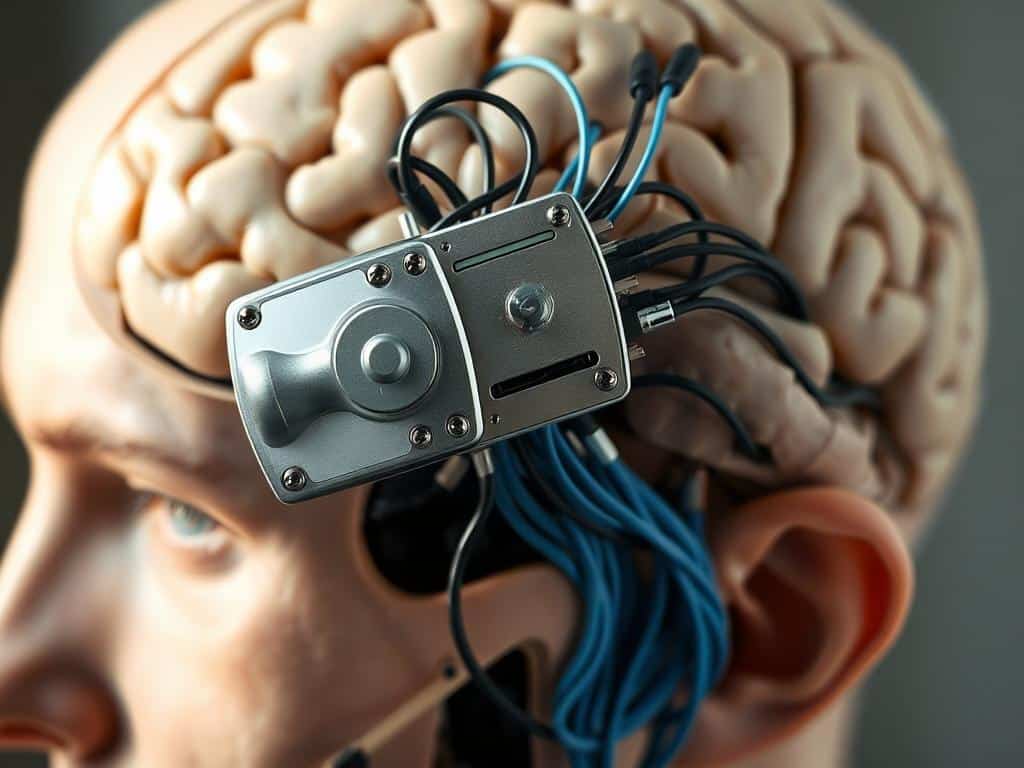
Did you know that by 2025, the global brain-computer interface market might hit $3 billion? We’re at the edge of a major shift, where controlling devices with our minds isn’t just fantasy. Thanks to fast progress in neurotech, especially brain-computer interfaces, we’re rethinking how we’ll interact with technology.
Companies like Elon Musk’s Neuralink are at the forefront, doing exciting clinical trials. This makes me wonder about a future where we overcome the limits of current communication. Could we really be using our minds to control machines by 2050?
Key Takeaways
- The global brain-computer interface market is projected to reach $3 billion by 2025.
- Neurotech is driving revolutionary changes in how we communicate with technology.
- Elon Musk’s Neuralink is leading early clinical trials in brain-computer interfaces.
- Mind-machine interfaces could redefine human communication.
- The future of technology may allow for thought-to-thought communication.
Understanding the Evolution of Communication
To understand how our ways of talking and sharing have changed, it’s important to look back at history. This journey shows a big change brought on by new technologies.
The Historical Context of Human Communication
Communication started simple, with cave paintings and telling stories by word of mouth. Then, we moved to writing, which changed everything about sharing ideas. Societies expanded and inventions like the printing press made it easier to spread knowledge.
When the telegraph and telephone came, talking over long distances became easy. This made a big difference in how we connect with others.
The Role of Emerging Technologies
Now, we’re seeing communication change faster than ever because of the internet. The internet lets us share things instantly, all over the world. Today’s new tech, like artificial intelligence, virtual reality, and brain-computer links, will make communication even more interesting. They’ll make things easier and challenge how we think about talking to each other, opening new ways to connect we haven’t even thought of yet.

The Impact of Brain-Computer Interfaces
Brain-computer interfaces (BCIs) are changing the field of neurotechnology. They are being used in different areas, especially in medicine. These technologies are improving the lives of people with disabilities.
For example, companies like Neuralink have completed early tests. They’ve let people control digital devices just with their thoughts. This shows the progress in brain-computer interface technology.
Current Developments in Neurotech
Looking at neurotechnology today, we see it’s not just for medical uses. My research shows that BCIs are creating new ways to interact with technology. They read brain signals, helping users do everyday tasks.
This marks a change in how we understand communication with machines.
Two-Way Communication and Future Potential
The idea of two-way communication is very exciting. REMspace is one example. It aims to enable communication during lucid dreams. Projects like this point to a thrilling future for neurotechnology.
As this tech grows, sharing thoughts in real time becomes more imaginable. This could drastically change how we communicate with each other. It might lead to a world where sharing thoughts is easy.
Conclusion
Looking ahead to 2050, brain-computer interfaces might change how we talk to each other. These tools could let us control gadgets with our thoughts. They might also change what we think about talking in the future. This change has big effects, especially for our privacy and how we connect with others.
The thought of turning our ideas into shared moments is exciting but also scary. We might share more directly, but we have to think about big questions. Questions like what it means to really be human. It’s key to keep a balance. We must make sure these techs make our human bonds stronger.
Thinking about the future with brain-computer interfaces needs careful thought and action. We have to understand these techs well. This way, we can aim for a future where talking is better but still keeps our human values. Standing at the start of this tech change, we must act wisely. Our goal should be to make our shared experiences richer, not poorer.